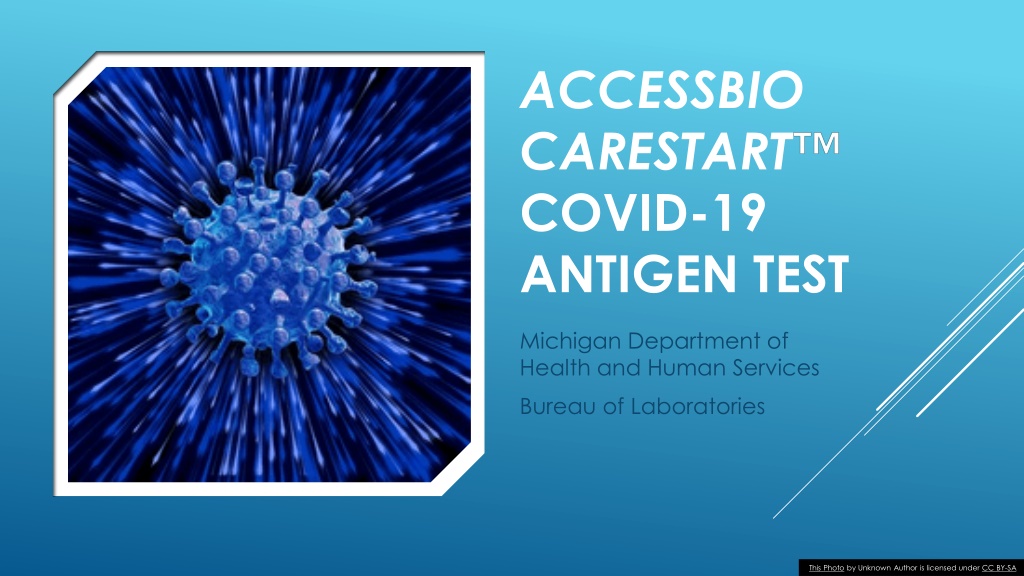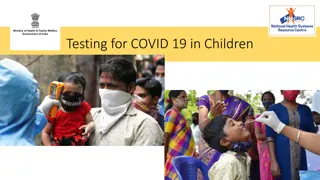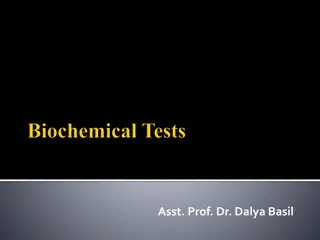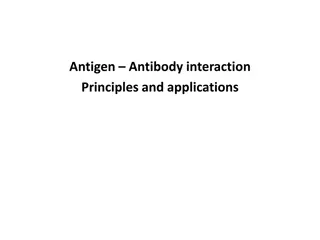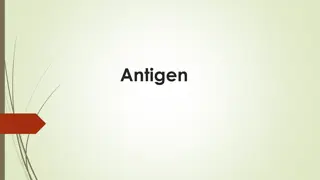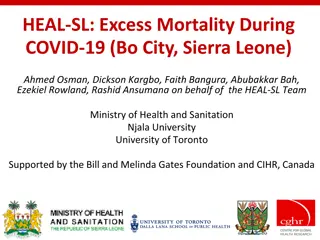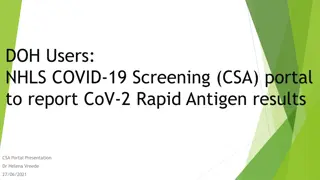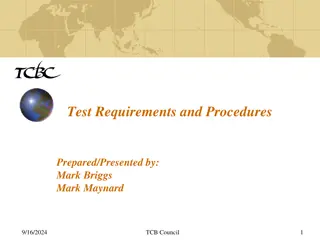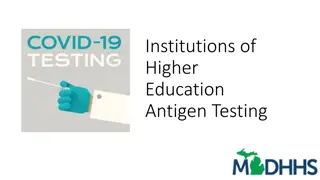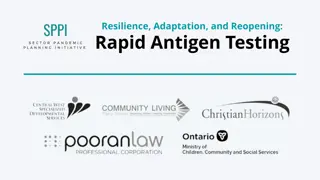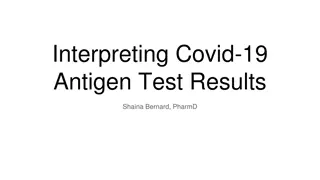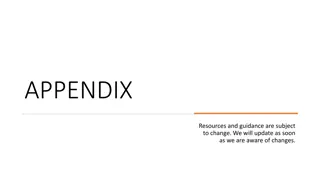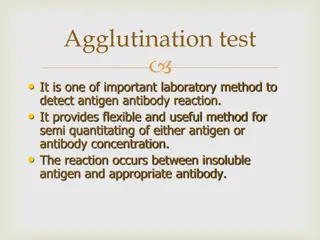Understanding CareStart COVID-19 Antigen Test Procedures and Safety Measures
This overview delves into the CareStart COVID-19 antigen test, touching on its approval status, intended use, safety precautions, how the test works, proper disposal and cleanup methods, and the importance of Personal Protective Equipment (PPE) during testing. The test involves specific procedures where swab samples are processed for the detection of SARS-CoV-2 antigens, with detailed safety guidelines emphasized to prevent the potential spread of COVID-19.
Download Presentation

Please find below an Image/Link to download the presentation.
The content on the website is provided AS IS for your information and personal use only. It may not be sold, licensed, or shared on other websites without obtaining consent from the author. Download presentation by click this link. If you encounter any issues during the download, it is possible that the publisher has removed the file from their server.
E N D
Presentation Transcript
ACCESSBIO CARESTART COVID-19 ANTIGEN TEST Michigan Department of Health and Human Services Bureau of Laboratories This Photo by Unknown Author is licensed under CC BY-SA
This test is approved is intended for use by trained operators and is for use under the Food and Drug Administration (FDA) Emergency Use Authorization (EUA) in settings which meet the CLIA requirements to perform moderate, high, or waived complexity tests. CARESTART COVID-19 ANTIGEN TEST
OBJECTIVES Review how the test works Safety and PPE Performing the test Result interpretation Disposal / Clean Up This Photo by Unknown Author is licensed under CC BY-SA
SAFETY Treat everything like it s positive for COVID-19 Wear PPE Don t use cell phones or touch personal items while testing Clean hands after removing gloves Do not eat or drink while doing testing Use appropriate disinfectant for clean-up (effective against COVID-19) Avoid touching hands and face while testing This Photo by Unknown Author is licensed under CC BY-SA
HOW CARESTART WORKS CareStart is a lateral test device in which the swab sample is eluted into extraction buffer solution and added to the test device The sample migrates through the test strip and the SARS-CoV-2 antigens in the sample combine with antibodies specific for SARS- CoV-2 The antigen/antibody complex binds to an indicator and is captured on the test strip then visualized as a line on the T Test line This test contains an internal control indicated on the C Control line which must appear for a valid test result how do lateral flow assays work - Bing images
PERSONAL PROTECTIVE EQUIPMENT (PPE) Respiratory Protection: Fitted N-95 is preferred. If N-95 is not available, use a surgical mask and face shield. Consult CDC resources for alternatives when N-95 s are not available. Eye/Face Protection: Safety glasses with N-95 or face shield with any respiratory protection Clothing Protection: If disposable lab coats are not available, consider bringing a change of clothes in case of contamination Gloves: mandatory for all steps of collection and testing
TEST KIT COMPONENTS Nasopharyngeal (NP) Swab: Sample must be collected by trained provider COVID-19 Antigen Extraction Vial Extraction Vial Caps COVID-19 Antigen Test Device Disposable vial holders/racks for holding the vials during the test set-up All waste is disposed as biohazardous waste
NEEDED BUT NOT PROVIDED All waste is disposed as biohazardous waste: Do not put test materials or PPE in regular garbage Disinfectant effective against COVID-19 60-80% ethanol/isopropanol 10% bleach solution Other effective EPA registered disinfectant Paper towels or absorbent material Hand sanitizer to use between patients after removing gloves
SET UP THE TEST AREA- 1 Allow all materials to equilibrate to room temperature before testing. Spread a paper towel out to use as a work surface- keep the table cleaner Find a timing device: a wall clock or kitchen timer works. Do not use your cell phone (contamination risk) You will need a biohazard waste container near your test space Have disinfectant handy and clean often, especially items that you touch with your gloves: pens, timers, etc.
SET UP THE TEST AREA- 2 Assemble a disposable elution tube rack found in the test box to hold the tube upright. To prevent contamination between tubes, use a Sharpie to mark it with an X when you ve put a tube in that position. Remove test device immediately before testing (do not open multiple at once) Use a sharpie to write a patient identifier on the elution tube and test device. To protect patient privacy, use an identifier other than patient name. Remove the aluminum foil seal from the elution tube Begin sample collection (NP swab)
SAMPLE COLLECTION Trained personnel will collect a nasopharyngeal (NP)sample using the swabs provided in the kit. Nasal washes and aspirate samples are not acceptable for testing Wear appropriate PPE during collection (gloves, respiratory protection and mucous membrane protection at minimum). The swab should be tested immediately after sample collection. Specimens are stable for 4 hours in the extraction buffer Swab specimens can be placed in BD universal transport media (this requires a small change in the testing procedure and a 400 l pipette) See the pkg insert for procedure.
Test Procedure 1. 3. 4. 2. Invert the extraction vial and hold the sample vertically above the sample well. Squeeze the vial gently. Allow three (3) drops of sample to fall into the sample well. Remove the swab by rotating against the extraction vial while squeezing the sides of the vial to release the liquid from the swab. Discard the swab in biohazard waste. Peel off aluminum foil seal and rotate the swab inside the extraction vial vigorously at least 5 times Close the vial by pushing the cap firmly onto the vial and mix thoroughly by flicking the bottom of the tube.
Read and Interpret Results After 10 Minutes This Photo by Unknown Author is licensed under CC BY-NC-ND The test result should not be read or interpreted after 15 minutes. ***For safety reasons, do not use personal cell phone as a timer***
Result Interpretation COVID-19 NEGATIVE INVALID COVID-19 POSITIVE If the red-colored line in the Control region C is not visible, the result is invalid (even if Test T line is visible) Repeat test using remaining sample in the extraction vial with a new test device (within 4 hours of addition to extraction buffer) Red Control Line C must be visible No Test Line T (blue) visible Red Control Line C visible Blue Test Line T visible Any faint colored line in the test region is considered positive
TEST LIMITATIONS Excess blood or mucous in the specimen may yield false- positive results Avoid touching any bleeding areas of the nasopharynx when collecting specimens False negative results may occur in patients taking >10mg of biotin per day Biotin levels of 2.5 mg/mL may result in false negative test results. This Photo by Unknown Author is licensed under CC BY-SA-NC
DISPOSAL After the test is reported, dispose of all materials in the biohazard container Remove your gloves, use hand sanitizer and put- on clean gloves before collecting and testing the next sample. Disposable PPE should also be discarded as biohazard waste. This Photo by Unknown Author is licensed under CC BY-SA
FINALLY Read the package insert found in the test kit before performing this test. For questions or to report a problem, contact the manufacturer s technical support line, found in the package insert. Some assistance can be given at checcdeptcoor@michigan.gov Return the training quiz to Bureau of Laboratories This Photo by Unknown Author is licensed under CC BY
